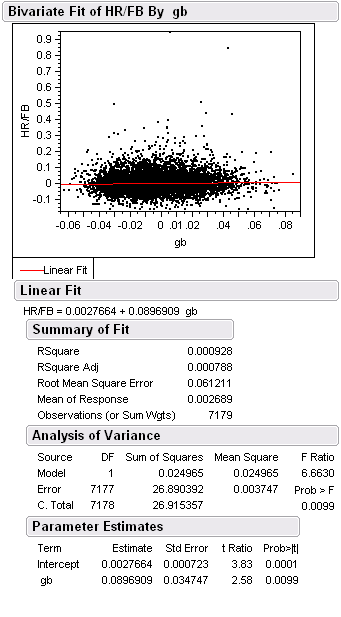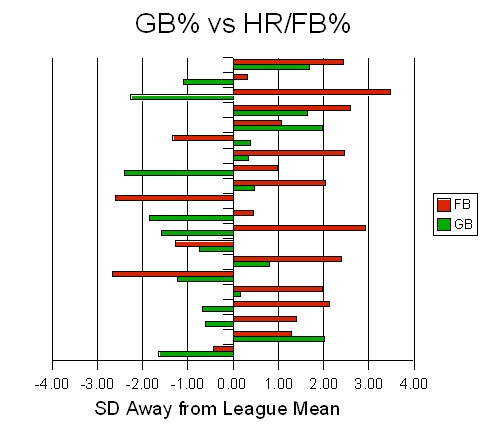Groundballs and home run rates
An evaluation system for pitchers that a friend of mine did sparked this thread over at The Book Blog. That’s inspired me to revisit some conclusions that David Gassko came to awhile back and that I arrived at separately in my pursuit of a better pitcher prediction model.
Those conclusions: The higher a pitcher’s groundball rate, the lower his home run per flyball rate. Though the statistical significance is weak, it does fly in the face of some accepted theory that extreme groundballers often have higher home run per flyball rates because, again in theory, what flyballs they do give up will more often be “mistake pitches” that are driven harder.
Gassko’s original work can be found here. Here’s the relevant excerpt:
The main advantage of a ground ball pitcher is supposed to be his ability to prevent balls from leaving the park. The basic idea is simple: A pitcher has little to no control over the rate at which his flyballs leave the park, as was shown in my study with JC Bradbury in The Hardball Times Annual 2006. However, as we also showed, pitchers exhibit very stable groundball rates from year to year. So if the only thing a pitcher can do to prevent home runs is to prevent flyballs, it stands to reason that groundball rate is a key factor in preventing home runs.
However, many have argued that this is not quite correct, because pitchers with high groundball rates generally allow flyballs only when they make a mistake. Since mistake pitches will be hit farther than your average fly, groundball pitchers should allow more home runs per flyball than your average pitcher. Is it true? The numbers say no. The correlation between a pitcher’s groundball rate and the percentage of the balls hit in the air against him (measured as outfield flyballs plus line drives) that land in the seats is -.05, otherwise known as nonexistent.
I arrived at the same conclusion when, while perusing my IPORT data, I plotted the career percentage of pitches resulting in groundballs (GB%) against home runs per flyball. This was not meant to be a perfectly sound statistical measure, but merely to satisfy my curiousity. The results were surprising, nonetheless.
Foraying into The Book Blog thread, I wanted to revise my approach to be more complete. I looked at groundball and home run per flyball rates for all pitcher seasons 1988-2006 sans 1999 (data from Retrosheet), normalized around the league’s numbers for each season and blocked on throwing hand.
That is, each season’s data were separated into left and right-handed pitchers and totals for each were gathered for each side, each season. The individual pitchers’ results were then normalized around the league’s results for that season for all pitchers of the same dexterity. Then, home run per flyball rate was again plotted against groundball rate, resulting in the following graph:

The results here are a little different from what I first saw and from what Gassko stated. Here there was no negative relationship in the linear model. However, it is quite clear that there is no overlying positive trend or spike and that any correlation drawn will be very weak. This would seem to support Gassko’s conclusion. In response, though, Tom Tango asked for a closer look at a particular segment of the data, sayinbg that the theory is pertaining more to the extremes and that measuring the difference in terms of standard deviations away from the league mean would be a more appropriate response.
Can do. So I went back, took the entire careers for pitchers that I have and took the top 20 groundballers, and just for fun, the top 20 flyballers, and separated them from the pack. Then I calculated the average home run per flyball rate for all pitchers 1988-2006 (13.57% as it turns out).
And, using the number of flyballs for each pitcher as the population mean for that pitcher, found the standard deviation for each pitcher as (p*q/n) or (.1357 – (1 – .1357)/No. of flyballs). Then I subtracted the pitcher’s home run per flyball rate from the league’s and finally, dividing that difference by the pitcher’s standard deviation yielded the sd-distance from the league mean for each pitcher, plotted below.

It is not easy to pick out a pattern in that graph—it is ordered at random—so let me offer a summary statistic. Taking each pitcher’s contribution (pitcher’s flyballs/sample flyballs) to the sample (top 20 flyballers or top 20 groundballers) and multiplying it by the sd-distance gives us a weighted magnitude for the group of how many standard deviations away from the mean they are.
The top 20 groundball pitchers had a magnitude of -0.28, while the bottom 20 groundball pitchers had a magnitude of +0.83. This tells us that the more extreme groundball pitchers are indeed seeing lower home run per flyball rates than the overall average, while the worst groundball pitchers are seeing higher home run per flyball rates than the overall average. The full data are presented below.
Last First T GB HRFB League FB SD Diff #SD
Coppinger Rocky R .2316 .2012 .1357 164 .027 .066 2.45
Cabrera Jose R .2786 .1422 .1357 267 .021 .006 0.31
Quevedo Ruben R .2814 .2007 .1357 339 .019 .065 3.49
Prokopec Luke R .2821 .1933 .1357 238 .022 .058 2.59
White Gabe L .2843 .1516 .1357 521 .015 .016 1.06
Percival Troy R .2874 .1151 .1357 488 .016 -.021 -1.33
Stein Blake R .2891 .1811 .1357 348 .018 .045 2.47
Person Robert R .2908 .1485 .1357 701 .013 .013 0.99
Wells Bob R .2974 .1653 .1357 563 .014 .030 2.05
Fernandez Sid L .2979 .1100 .1357 1207 .010 -.026 -2.61
Dotel Octavio R .2989 .1434 .1357 426 .017 .008 0.46
Creek Doug L .3005 .2002 .1357 240 .022 .065 2.92
Niedenfuer Tom R .3013 .1027 .1357 175 .026 -.033 -1.27
Rose Brian R .3032 .1965 .1357 183 .025 .061 2.40
Reardon Jeff R .3047 .0921 .1357 435 .016 -.044 -2.66
Milton Eric L .3049 .1531 .1357 1503 .009 .017 1.97
Helling Rick R .3108 .1559 .1357 1310 .009 .020 2.13
Almanza Armando L .3118 .1711 .1357 187 .025 .035 1.41
Springer Russ R .3151 .1536 .1357 599 .014 .018 1.28
Guante Cecilio R .3166 .1256 .1357 223 .023 -.010 -0.44
Webb Brandon R .7020 .1650 .1357 387 .017 .029 1.68
Wang Chien-Ming R .6686 .1089 .1357 193 .025 -.027 -1.09
Innis Jeff R .6554 .0807 .1357 198 .024 -.055 -2.26
Hernandez Felix R .6522 .1811 .1357 155 .028 .045 1.65
Lowe Derek R .6426 .1612 .1357 700 .013 .026 1.97
Bradford Chad R .6388 .1467 .1357 150 .028 .011 0.39
Swift Bill R .6335 .1401 .1357 715 .013 .004 0.34
McDowell Roger R .6257 .0905 .1357 333 .019 -.045 -2.41
Swan Russ L .6255 .1481 .1357 169 .026 .012 0.47
Westbrook Jake R .6216 .1358 .1357 537 .015 .000 0.01
Frohwirth Todd R .6090 .0952 .1357 241 .022 -.041 -1.84
Brown Kevin R .6064 .1218 .1357 1514 .009 -.014 -1.58
Cook Aaron R .6018 .1223 .1357 359 .018 -.013 -0.74
Dopson John R .5996 .1487 .1357 457 .016 .013 0.81
Kolb Danny R .5983 .1018 .1357 157 .027 -.034 -1.24
Day Zach R .5979 .1392 .1357 244 .022 .004 0.16
Young Matt L .5974 .1222 .1357 286 .020 -.014 -0.67
Corsi Jim R .5923 .1215 .1357 222 .023 -.014 -0.62
Florie Bryce R .5908 .1836 .1357 207 .024 .048 2.01
Guetterman Lee L .5903 .1033 .1357 299 .020 -.032 -1.64
So again, even looking at the most extreme groundball pitchers, it seems that the intuitive logic of mistake pitches impacting the home run per flyball rate does not hold. The most prolific groundball pitchers do not suffer higher home run per flyball rates. In fact, though extremely weakly correlated, it appears to be the opposite.
References & Resources
The information used here was obtained free of charge from and is copyrighted by Retrosheet. Interested parties may contact Retrosheet at http://www.retrosheet.org.

The wardrobe is shaken up through and through, lending itself to the mixing of genres, peculiar layering, expert dissonance and pseudo-paradoxical juxtapositions. A clash of competing allusions.